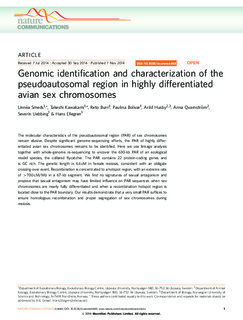| dc.contributor.author | Burri, Reto | |
| dc.contributor.author | Bolivar, Paulina | |
| dc.contributor.author | Husby, Arild | |
| dc.contributor.author | Qvarnström, Anna | |
| dc.contributor.author | Uebbing, Severin | |
| dc.contributor.author | Ellegren, Hans | |
| dc.contributor.author | Smeds, Linnea | |
| dc.contributor.author | Kawakami, Takeshi | |
| dc.date.accessioned | 2015-09-29T12:04:18Z | |
| dc.date.accessioned | 2015-10-23T12:16:49Z | |
| dc.date.available | 2015-09-29T12:04:18Z | |
| dc.date.available | 2015-10-23T12:16:49Z | |
| dc.date.issued | 2014 | |
| dc.identifier.citation | Nature Communications 2014, 5 | nb_NO |
| dc.identifier.issn | 2041-1723 | |
| dc.identifier.uri | http://hdl.handle.net/11250/2357933 | |
| dc.description.abstract | The molecular characteristics of the pseudoautosomal region (PAR) of sex chromosomes
remain elusive. Despite significant genome-sequencing efforts, the PAR of highly differentiated
avian sex chromosomes remains to be identified. Here we use linkage analysis
together with whole-genome re-sequencing to uncover the 630-kb PAR of an ecological
model species, the collared flycatcher. The PAR contains 22 protein-coding genes and
is GC rich. The genetic length is 64cM in female meiosis, consistent with an obligate
crossing-over event. Recombination is concentrated to a hotspot region, with an extreme rate
of 4700cM/Mb in a 67-kb segment. We find no signatures of sexual antagonism and
propose that sexual antagonism may have limited influence on PAR sequences when sex
chromosomes are nearly fully differentiated and when a recombination hotspot region is
located close to the PAR boundary. Our results demonstrate that a very small PAR suffices to
ensure homologous recombination and proper segregation of sex chromosomes during
meiosis. | nb_NO |
| dc.language.iso | eng | nb_NO |
| dc.publisher | Nature Publishing Group | nb_NO |
| dc.title | Genomic identification and characterization of the pseudoautosomal region in highly differentiated avian sex chromosomes | nb_NO |
| dc.type | Journal article | nb_NO |
| dc.type | Peer reviewed | en_GB |
| dc.date.updated | 2015-09-29T12:04:18Z | |
| dc.source.volume | 5 | nb_NO |
| dc.source.journal | Nature Communications | nb_NO |
| dc.identifier.doi | 10.1038/ncomms6448 | |
| dc.identifier.cristin | 1253583 | |
| dc.description.localcode | This work is licensed under a Creative Commons Attribution 4.0 International License. The images or other third party material in this article are included in the article’s Creative Commons license, unless indicated otherwise in the credit line; if the material is not included under the Creative Commons license, users will need to obtain permission from the license holder to reproduce the material. To view a copy of this license, visit http://creativecommons.org/licenses/by/4.0/ | nb_NO |
